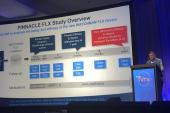NCDR Analyses Offer Insights Into First-Generation Watchman Outcomes
Researchers say the real-world results are “reassuring” and may help point the way for future management and trials.

Two newly published studies shed light on how real-world patients with atrial fibrillation fared after undergoing left atrial appendage occlusion (LAAO) with the first-generation Watchman device (Boston Scientific), as well as the kind of postprocedure antithrombotic drugs they received.
In an analysis of postmarket registry data of patients treated between 2016 and 2018, those who received the Watchman had fewer complications and lower risk of implant failure or ischemic stroke than patients who were treated with the device in the PREVAIL and PROTECT-AF trials that led to US Food and Drug Administration approval in 2015.
In a second study using the same registry, researchers led by James Freeman, MD (Yale School of Medicine, New Haven, CT), found frequent deviations from the postprocedural pharmacologic therapy given in the trials, with only one in 10 real-world patients receiving the full protocol that was stipulated. It is not surprising for protocols to shift and change once they enter real-world practice, Freeman told TCTMD, noting that the “most common deviation from postprocedural protocols that were delineated in the trials is the discharge antithrombotic strategy.”
Both papers were published online yesterday, in JACC: Cardiovascular Interventions and the Journal of the American College of Cardiology, respectively.
Balancing Bleeding Risks
For the antithrombotic study, Freeman and colleagues examined data from the LAAO Registry, part of the American College of Cardiology’s National Cardiovascular Data Registry, which includes active patient follow-up of Watchman procedures. Their analysis included 31,994 patients (mean age 76 years; 41% female). Nearly all (98.2%) were discharged on an anticoagulant and/or antiplatelet.
Registry patients were discharged on warfarin and aspirin (36.9%), a direct oral anticoagulant (DOAC) and aspirin (20.8%), warfarin alone (13.5%), DOAC alone (12.3%), and a small number of patients (5.0%) discharged on dual antiplatelet therapy (DAPT).
The risk of any adverse event within 45 days was lower in those taking warfarin alone or a direct oral anticoagulant (DOAC) alone compared with warfarin and aspirin as used in the trials, although the risk of major bleeding was higher. At 6 months, the rate of any adverse event was highest among those treated with warfarin and aspirin (10.3%), followed by DAPT (9.1%), DOAC and aspirin (9.1%), warfarin (8.5%), and DOAC (8.3%).
“This is observational data, but this strongly suggests that the use of an antiplatelet agent in addition to anticoagulation may not be necessary,” Freeman added. “It's important to note that we didn't see an increase at all in thrombotic complications—in stroke or thromboembolism of any sort—associated with getting rid of the aspirin. It really just seemed to increase bleeding risk. . . . All of these strategies appeared reasonable.” That being said, in the current era, anticoagulation alone with a DOAC may be the optimal strategy for most patients, he said, although more data are needed for confirmation.
In an editorial accompanying Freeman’s study, David R. Holmes Jr, MD (Mayo Clinic, Rochester, MN), the primary investigator of PREVAIL, notes that the new findings regarding anticoagulation are in line with those of the POPular TAVI trial, which found that patients who received clopidogrel on top of an oral anticoagulant regimen had more bleeding, with no apparent benefits.
“The future is ripe and bright for ongoing and new trials to document optimal strategies balancing the risks of bleeding versus thrombotic events, such as device-related thrombus and acute ischemic and hemorrhagic strokes, in this expanding group of patients,” Holmes writes.
Some Excess Mortality Seen
In the second study, led by Daniel J. Friedman, MD (Duke University Hospital, Durham, NC), with Freeman as senior author, investigators performed a patient-level analysis that matched the NCDR’s LAAO Registry patients with Watchman patients or warfarin patients from PROTECT-AF and PREVAIL.
Compared with Watchman patients in the trials, the registry patients had less pericardial effusion requiring intervention (0.6% vs 3.8%; P < 0.001), periprocedural ischemic stroke (0.2% vs 0.9%; P = 0.005), or failed device implantation (3.6% vs 7.5%; P < 0.001). At 425 days, the rate of ischemic stroke was 2.7% in the trial-based Watchman patients and 1.2% in the registry patients (P = 0.03). Hemorrhagic stroke risk was similar between both groups (P = 0.88). However, all-cause mortality was lower in the trials than in the registry (2.9% vs 6.2%; P = 0.004).
This data is really reassuring that, in general, the device is performing favorably relative to what was seen in the clinical trials. James Freeman
“Our conjecture with that is just that that's probably an issue of residual confounding where the patients in the real world who are getting this device are definitely higher risk,” Freeman said. “The overall take home here is this data is really reassuring that in general, the device is performing favorably relative to what was seen in the clinical trials.” Still, the researchers say the excess mortality does warrant further study.
As for the comparisons of the registry patients to the warfarin trial patients, hemorrhagic stroke risk was greater with warfarin (1.44% vs 0.20%; P = 0.03), but mortality rates were similar (P = 0.44), as were rates of ischemic stroke (P = 0.57).
In an accompanying editorial to Friedman’s study, Stephen A. Tang, MD, and Shephal K. Doshi, MD (both Pacific Heart Institute, Santa Monica, CA), say this look at the registry data expands understanding of how the Watchman device performs in patients with more comorbidities than those of the trial populations, and includes 13% more women.
Tang and Doshi suggest the findings of less pericardial effusion requiring intervention, periprocedural ischemic stroke, and failed device implantation likely reflect “operator learning curve and implanter experience with transeptal puncture, device deployment, and reduction in air embolism.” However, they note that the propensity matching did not account for all variables, which could explain the higher rate of all-cause mortality in the registry patients.
While it is reasonable to balance the strict enrollment criteria used in RCTs with the desire to provide alternatives to patients not optimally treated with standard therapies, “equipoise can change quickly,” the editorialists write, “and while caution should be exercised in performing LAAO in patient populations that have not been studied rigorously, it is only through large databases such as the NCDR that we can rapidly collect such valuable data.”
Both of these analyses concerned the first-generation Watchman device. Just this weekend at the Heart Rhythm 2022, Freeman presented additional data on the next-generation Watchman device—the Watchman FLX—showing that compared with first-generation registry patients, the new design is associated with fewer in-hospital major adverse events, driven by a “marked decrease” in pericardial effusion requiring intervention (0.42% vs 1.23%), with significantly lower rates of death, device embolization, cardiac arrest, and major bleeding.
L.A. McKeown is a Senior Medical Journalist for TCTMD, the Section Editor of CV Team Forum, and Senior Medical…
Read Full BioSources
Freeman JV, MD, Higgins AY, Wang Y, et al. Antithrombotic therapy after left atrial appendage occlusion in patients with atrial fibrillation. J Am Coll Cardiol. 2022;79:1785-1798.
Holmes DR. Antithrombotic therapy after left atrial appendage occlusion: cornucopia and Gertrude Stein. J Am Coll Cardiol. 2022;79:1799-1801.
Friedman DJ, Du C, Wang Y, et al. Patient-level analysis of Watchman left atrial appendage occlusion in practice versus clinical trials. J Am Coll Cardiol Intv. 2022;15:950-961.
Tang SA, Doshi SK. Left atrial appendage occlusion: practice makes perfect? J Am Coll Cardiol Intv. 2022;15:962-964.
Disclosures
- Freeman reports salary support from the ACC NCDR and the NHLBI; and consulting/advisory board fees from Boston Scientific, Medtronic, Janssen Pharmaceuticals, and Biosense Webster.
- Friedman reports educational grants from Boston Scientific, Medtronic, and Abbott; research grants from the NCDR, Boston Scientific, Abbott, Medtronic, and Biosense Webster; and consulting fees from Abbott and AtriCure.
- Tang and Holmes report no relevant conflicts of interest.
- Doshi reports research and grant support from Boston Scientific and Abbott.





Comments